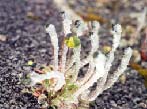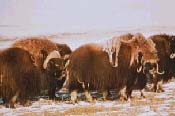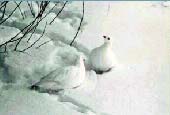Proactive disclosure
Print version   |  | 
Natural Resources Canada > Earth Sciences Sector > Priorities > Climate Change Impacts and Adaptation > Climate Change in Canada
Degrees of Variation : Climate change in Nunavut Life on the land
The future...
Climate warming is predicted to cause increased plant growth, a northward movement of the treeline, declines in snow cover and the thickness and extent of permafrost, reduced browse for caribou, decreased water availability; and increased forest fires.

Arctic willows - a warmer climate may enable this species to become more widespread in the High Arctic Islands
(S.A. Edlund, GSC 2000-057) |

Tall willows - a warmer climate may enable this species to move into more of the southern Arctic Islands
(S.A. Edlund, GSC 2000-057C) |
Vegetation...
Due to low nutrient supply in the soil, doubling the amount of CO2 in the atmosphere will have relatively little direct effect on plant growth in the Arctic; however, warmer temperatures resulting from increased CO2 could change the tundra thaw depth, litter quality, and soil nutrients. As a result, it is expected that species currently at their northern limit will expand northward. In southern areas, tundra vegetation may disappear and in the remaining northern tundra areas, there would be more shrub cover and a decrease in forbs and lichens.

Artic poppy
(S.A. Edlund, GSC 2000-057A) |

Ice-covered arctic poppy
(D.G. Hodgson, GSC 2000-056C) |
Wildlife...
Warming is expected to increase food availability for plant-eating animals; however, changes in the timing of these food sources, an increase in parasites and insect-borne disease, and more insect harassment may lead to population declines. In addition, southern species may slowly begin to move into the area and increase competition for food and space with traditional animal species.
Ottawa Citizen - April 18, 2000
Inuit Track Early Global Warming Trends: Report Documents Unusual Sightings of Birds, Animals in the Arctic
Caribou and muskoxen are very dependent on access to tundra vegetation, so an increase in encrusted snow cover may put such vegetation beyond their reach. Many large mammals also migrate to seasonal feeding grounds. Changes in the timing and extent of ice cover may see a change in migration patterns or an increase in drownings as they attempt to cross unsafe ice.

Muskoxen
(Northwest Territories Dept. of
Information/NWT Archives) |

Caribou
(C. Gilbert, GSC 2000-053D) |

Lemming
(S. Wolfe, GSC 2000-059A) |
Ice-layered snow may create problems for small mammals. Ice layers trap CO2 causing it to build up under the snow. As CO2 levels rise, small mammals can be poisoned by the gas or forced to the surface, where they may freeze or be caught by a predator.
Birds and waterfowl...
In northern regions, warming may extend nesting periods, provide more food for young and decrease chick mortality. In the southern regions, however, particularly the mainland, warming may reduce breeding and forage habitats. Sea-level rise may also damage important shoreline nesting areas and increased storms during nesting season could destroy essential nesting efforts, eggs, and chicks.

Red Knot
(S.D. Robinson, GSC 2000-055) |

Ptarmigan in the snow
(NWT Archives) |
Local impacts...
Changes in the range and abundance of animals may mean local adjustments to traditional hunting and harvesting strategies. It may also mean changes to traditional diet. In addition, the meat quality is expected to decline and this may affect nutritional health of people dependant on country food.
Did you know?
The Queen Maud Gulf lowlands are a major breeding and nesting ground for migratory birds. Climate warming may change this sensitive environment and adversely affect bird populations.
|
